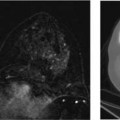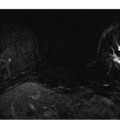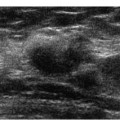8 Digital Mammographic Characteristics of Architectural Distortion Like asymmetries, there are few studies comparing the appearance of architectural distortion on digital mammography to screen-film mammography. Clinical investigators report small numbers of cases with either very few1 or moderate2 discrepancies in assessment between the two techniques for this finding. However, in these studies, the overall difference in cancer detection is not significant, and no unique cause for these discrepancies is reported. To identify architectural distortion, it is important to understand the appearance of normal breast architecture. Normally, the edges of the fibroglandular tissue consist of curvilinear lines that are oriented toward the nipple. This radiating linear pattern is disrupted only by blood vessels. Adjacent to the subcutaneous fat, Cooper’s ligaments form a scalloped edge. The fibroglandular edges of the breast gradually decrease in density toward the chest wall and axilla. In patients with scattered or heterogeneously dense fibroglandular composition, the edges form ill-defined curvilinear feathery borders. In patients with extremely dense composition, the edges adjacent to the axilla and chest wall commonly have the same scalloped appearance as the anterior subcutaneous parenchymal border. These patients generally exhibit a curvilinear or rounded superior border on the mediolateral oblique (MLO) view and the medial and lateral corners of the craniocaudal (CC) view. Architectural distortion consists of straight lines, lines not oriented toward the nipple, and angular edges. It may be divided into three main locations: peripheral, central, and subareolar. Peripheral architectural distortion is readily visible in all categories of breast composition. This type of distortion is due to a lesion projecting beyond the normal fibroglandular edge or is the result of a lesion producing fibrosis or spiculation in the periphery of the fibroglandular tissue. A mass projecting beyond the fibroglandular edge is generally easy to detect: there is a focal convex margin. However, identification may be difficult if the mass is small (<5 mm) and extends outside the field of view of the mammogram. In this case, one must spot the thin “trail” of abnormal tissue that commonly connects the mass to the main fibroglandular density. When a peripheral mass causes retraction of surrounding tissues in the posterior one third of the breast near the chest wall, the glandular tissue forms a horizontal V, which has been labeled the “tent sign.” When distortion occurs in the superior fibroglandular border, the edge of the tissue becomes pointed, like an arrowhead. Furthermore, the density of this “arrow” is often slightly higher than the opposite side. This superior distortion is subtle; so long-term comparison examinations are useful to demonstrate the progression of distortion. If the superior fibroglandular edge is triangular, asymmetric with the opposite side, and has changed over time, one should be suspicious of a mass.
 General Evaluation of Architectural Distortion
General Evaluation of Architectural Distortion
Stay updated, free articles. Join our Telegram channel

Full access? Get Clinical Tree






